
Homemade Face Mask
How to make a face mask
The best way to make a face mast is to follow these CDC guidelines. With new recommendations from the CDC, you might be wondering how to make a homemade face mask. These masks aren’t N95, or surgical, grade fabrics but can help prevent the spread of COVID-19 to other people. The recommendations changed after recent studies showed the active infection curve comparing South Korea’s active infected population with that of Italy. South Korea is recommending their civilians wear face masks in public places whereas Italy did not.

It is now recommended to wear a face mask in public spaces if you need to go out for any reason. These recommendations recently changed with the rise in COVID-19 cases around the United States. Let’s explore some different ways to make a homemade face mask.
Cloth Face Covering
Here’s how you can make your own face covering in a few easy steps, with items you can find around the house. Video is directly from Surgeon General Jerome Adams and the CDC.
Step1: Find and old scarf, bandana or hand towel, or t-shirt
Step2: Fold the fabric from the bottom to the middle
Step3: Fold the fabric from the top to the middle
Step4: Fold the fabric again from the bottom to the middle and the top to the middle.
Step5: Take two rubber bands and place them on both sides of the folded cloth
Step6: Fold the edges over the rubber bands and you now have a cloth face mask. See video for visual instructions from the CDC.
For more ways to make effective homemade face masks and questions regarding face masks, go to this CDC web page.
Bandanna Face Mask with Filter
Materials
- Bandanna (or a 20”x20” cloth)
- Coffee Filter
- Rubber Bands or Hair Ties
- Scissors (if you are cutting your own cloth)

A mask is not a substitute for social distancing
A mask is never a substitute for social distancing. Please adhere to the CDC guidelines and social distance yourself from people and public places. It is up to all of us to do our part and stay home to protect loved ones and those we have never met before.
Sewn Cloth Face Covering
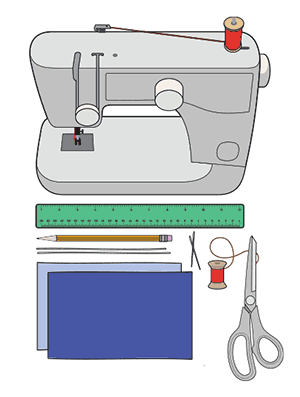
Materials
- Two 10”x6” rectangles of cotton fabric
- Two 6” pieces of elastic (or rubber bands, string, cloth strips, or hair ties)
- Needle and thread (or bobby pin)
- Scissors
- Sewing machine
Tutorial
1. Cut out two 10-by-6-inch rectangles of cotton fabric. Use tightly woven cotton, such as quilting fabric or cotton sheets. T-shirt fabric will work in a pinch. Stack the two rectangles; you will sew the mask as if it was a single piece of fabric.
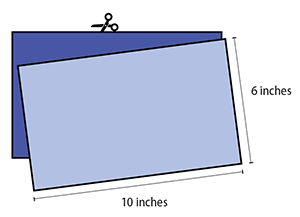
2. Fold over the long sides ¼ inch and hem. Then fold the double layer of fabric over ½ inch along the short sides and stitch down.
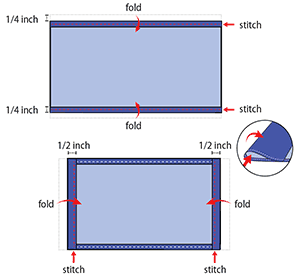
3. Run a 6-inch length of 1/8-inch wide elastic through the wider hem on each side of the mask. These will be the ear loops. Use a large needle or a bobby pin to thread it through. Tie the ends tight.
Don’t have elastic? Use hair ties or elastic head bands. If you only have string, you can make the ties longer and tie the mask behind your head.
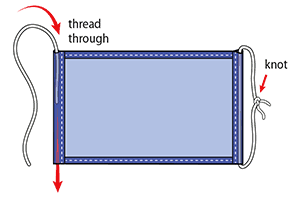
4. Gently pull on the elastic so that the knots are tucked inside the hem. Gather the sides of the mask on the elastic and adjust so the mask fits your face. Then securely stitch the elastic in place to keep it from slipping.
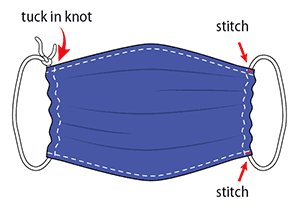
Effectiveness of materials
Some materials are going to be more effective than others due to the number of particles that can pass through the fabric and their breath-ability. Below is a chart from Stanford Medicine showing the effectiveness of household materials being used for face masks
To learn more about PPE, read here.
 Neck Gaiter Face Mask
Neck Gaiter Face Mask
Instead of buying fabric and sewing your own face mask, you can also buy a neck gaiter and use it as a face covering instead. These neck gaiters are great for public outings or using them on a fishing trip. Gaiterco.com has the best domestic neck gaiter on the market. Most neck gaiter companies import their fabrics from China or India. The Gaiterco.com knits their neck gaiters in North Carolina. They are constructed from Revolution yarns making them bleach cleanable and easy to clean in the washing machine with your clothes. These neck gaiters also have antimicrobial silver ions that are fully encapsulated in the yarns. This prevents the silver ions from being washed out and can be used over and over again. To purchase the absolute best neck gaiter on the market visit Gaiterco.com or on our website here
To purchase a USA made neck gaiter, click on this link
Any material being fashioned as a face mask is better than no face mask. Please stay at home, stay safe, social distance, but if you must go out, make yourself a face mask to help flatten the coronavirus curve here in the United States and our world. Thank you for reading the blog– James
 Neck Gaiter Face Mask
Neck Gaiter Face Mask
Comments
Leave a comment